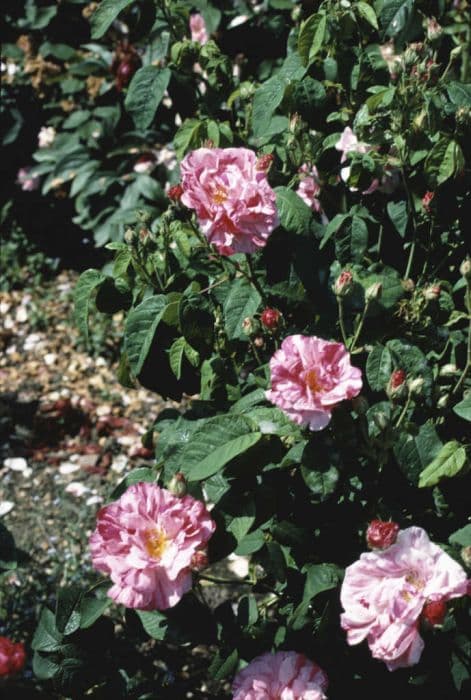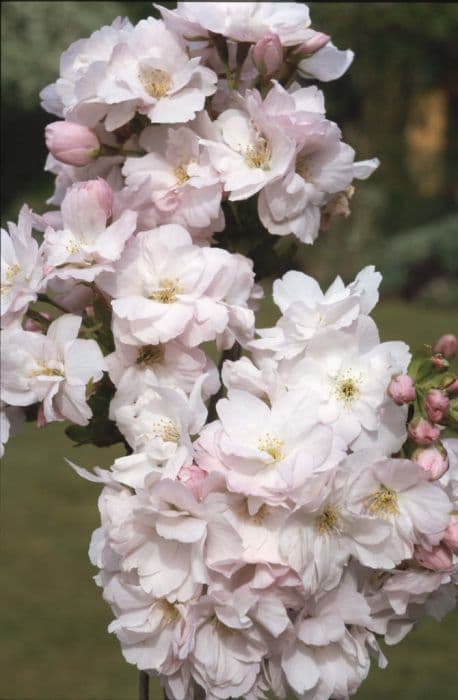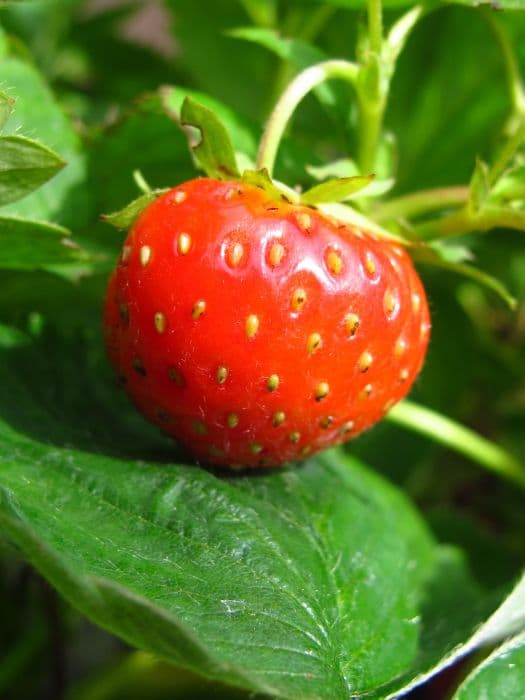Purple Sheep's Burr Acaena inermis 'Purpurea'

ABOUT
The plant commonly known as Purple Sheep's Burr showcases a striking purple foliage that bears a resemblance to finely dissected leaves. Throughout the seasons, the leaves offer a changing spectacle of hues, from a more intense purple during cooler temperatures to a softer toned color as it gets warmer. The foliage grows close to the ground in a dense mat, providing a rich textural quality. This ground-covering characteristic makes it an excellent choice for adding vibrant patches of color to the garden tapestry. In addition to its colorful leaves, Purple Sheep's Burr produces small, globular flower heads that may seem inconspicuous against the boldness of the foliage. These flower heads often have a burr-like appearance, giving the plant its common name. After the blooming period, the flowers are typically followed by spiky fruits that cling to fur and clothing, a trait that has enabled the plant to spread efficiently in the wild. This plant enjoys well-drained soil and a sunny to partly shaded position in the garden. It's often selected for its low-maintenance nature and its ability to thrive in a variety of conditions, although it shows a preference for cooler climates. The combination of its colorful foliage and its sprawling growth habit makes Purple Sheep's Burr a distinctive ground cover option for gardeners looking to add texture and year-round color.
About this plant
 Names
NamesFamily
Rosaceae.
Synonyms
Purple Sheep's Burr, Purple Goose Leaf, Purple New Zealand Burr, Purple Acaena.
Common names
Acaena inermis 'Purpurea'.
 Toxicity
ToxicityTo humans
Purple Goosefoot is not commonly known to be toxic to humans. However, as with any plant not typically consumed for food, it is possible that some individuals could experience an allergic reaction or irritation, especially if they have sensitive skin or if they ingest the plant. There is no widely documented case of poisoning from this plant, so symptoms from ingestion are not well established. It is always wise to err on the side of caution and avoid ingesting plants not known to be safe for consumption.
To pets
Purple Goosefoot is not widely recognized as a toxic plant to pets. However, as with humans, the ingestion of non-food plants can sometimes lead to gastrointestinal upset in animals, including symptoms like vomiting or diarrhea. Pets do not commonly eat this plant, and there are no major reported cases of poisoning. Nevertheless, pet owners should supervise their animals outdoors and prevent them from eating ornamental plants to avoid any potential issues.
 Characteristics
CharacteristicsLife cycle
Perennials
Foliage type
Evergreen
Color of leaves
Purple
Height
4 inches (10 cm)
Spread
20 inches (50 cm)
Plant type
Herb
Hardiness zones
6
Native area
New Zealand
Benefits
 General Benefits
General Benefits- Ground Cover: Acaena inermis 'Purpurea', commonly known as Purple Sheep's Bur, acts as an effective ground cover, spreading over the soil and reducing weed growth.
- Ornamental Value: With its unique purple-tinged foliage and attractive burr-like seed heads, it adds an interesting texture and color contrast to gardens.
- Low Maintenance: The plant is known for requiring minimal care, making it ideal for gardeners looking for low-maintenance landscaping options.
- Drought Tolerance: Once established, the Purple Sheep's Bur is drought-resistant, which is beneficial in regions with water restrictions or low rainfall.
- Erosion Control: The mat-forming habit of this plant helps stabilize soil and prevent erosion on slopes or banks.
- Wildlife Attraction: The plant can attract insects and provide food for birds, supporting local biodiversity.
- Adaptability: It thrives in a wide range of soil types, from sandy to loamy, as long as the site is well-drained.
 Medical Properties
Medical Properties- This plant is not used for medical purposes.
 Air-purifying Qualities
Air-purifying QualitiesThis plant is not specifically known for air purifying qualities.
 Other Uses
Other Uses- Lawn alternative: Acaena inermis 'Purpurea', also known as Purple Gooseleaf, is a low-growing ground cover that can serve as an attractive lawn alternative, requiring less maintenance.
- Garden accent: The Purple Gooseleaf's striking purplish foliage adds contrast when planted among green-leaved plants, creating a visually appealing garden design.
- Erosion control: The dense mat formed by Purple Gooseleaf can be effective in preventing soil erosion on slopes or in areas prone to water run-off.
- Living mulch: Its thick growth habit helps suppress weeds, making it a functional living mulch that also conserves soil moisture.
- Butterfly garden: Flowers of the Purple Gooseleaf may attract butterflies, enhancing the biodiversity of a garden space.
- Green roof planting: Due to its low maintenance and hardy nature, Purple Gooseleaf is suitable for green roof installations.
- Border edging: Its compact and creeping nature makes it suitable for creating defined edges along garden beds or walkways.
- Creative crafting: Dried burrs from the plant can be used in creative crafts or for adding texture to floral arrangements.
- Photography prop: The unique appearance of the Purple Gooseleaf can provide an intriguing subject or backdrop for photography enthusiasts, particularly in macro photography.
- Foot traffic zones: This plant can tolerate light foot traffic, making it a practical addition to outdoor living spaces where it can soften hardscapes.
Interesting Facts
 Feng Shui
Feng ShuiThe plant Acaena inermis 'Purpurea', commonly known as Purple Sheep's Bur, is not used in Feng Shui practice.
 Zodiac Sign Compitability
Zodiac Sign CompitabilityPurple Sheep's Bur is not used in astrology practice.
 Plant Symbolism
Plant Symbolism- Tenacity: The Acaena inermis 'Purpurea', commonly known as Purple Goose Leaf, often symbolizes tenacity due to its ability to thrive in various conditions and its vigorous growth habit.
- Protection: With its spiny burrs that adhere to animals and people, the plant has been associated with protection, as it can seem to create a defensive barrier.
- Resilience: The robustness and adaptability of Purple Goose Leaf make it a symbol of resilience, standing strong through different weather conditions and seasons.
 Water
WaterThe Purple New Zealand Burr requires moderate watering to remain healthy, generally about 1 inch of water per week, either from rainfall or manual watering. It's best to water deeply and less frequently to encourage root growth; for example, you could apply roughly 0.5 gallons per square foot every week, depending on the weather conditions. Allow the soil to dry out somewhat between waterings to prevent root rot. Overhead watering is not recommended as it can lead to leaf diseases; instead, water directly at the base of the plant. During hot, dry periods, you may need to increase the watering frequency.
 Light
LightPurple New Zealand Burr thrives best in full sun to partial shade conditions. A location that receives at least 6 hours of sunlight daily is ideal, but it can also tolerate some shade, particularly in hotter climates. Avoid placing it in deep shade, as it tends to become leggy and lose its vibrant color.
 Temperature
TemperatureThe ideal temperature range for Purple New Zealand Burr is between 60°F and 75°F. It can tolerate temperatures down to 20°F and up to about 85°F without significant damage. To ensure robust growth, try to maintain it within this temperature range and protect it from extreme cold by providing mulch or shelter during harsh winter conditions.
 Pruning
PruningPruning Purple New Zealand Burr helps to maintain its shape and encourage denser growth. Trim the plant lightly in early spring to remove any dead or damaged foliage and to shape it. Prune before new growth starts, typically once a year, which is sufficient for this low-maintenance plant. Deadheading is not necessary, as it rarely blooms or sets conspicuous seed heads.
 Cleaning
CleaningAs needed
 Soil
SoilThe Purple Goose Leaf thrives in well-draining soil with a mixture of loam, sand, and compost. The ideal soil pH ranges from slightly acidic to neutral, around 6.0 to 7.0. Amend with organic matter to encourage healthy growth.
 Repotting
RepottingThe Purple Goose Leaf plant doesn't require frequent repotting; it can be done every 2-3 years or when the plant outgrows its current container, ensuring minimal disturbance to its root system.
 Humidity & Misting
Humidity & MistingThe Purple Goose Leaf prefers moderate humidity levels but is quite adaptable; it does not have any special requirements for humidity, making it a versatile choice for various indoor environments.
 Suitable locations
Suitable locationsIndoor
Place in bright light, let soil dry slightly between waterings.
Outdoor
Plant in sun to part shade, well-draining soil, water regularly.
Hardiness zone
6-9 USDA
 Life cycle
Life cycleAcaena inermis 'Purpurea', commonly known as the Purple Sheep's Burr, begins its life as a seed, which germinates in spring or early summer when soil temperatures are warm and moisture is available. The seedling emerges, developing into a rosette of leaves, which are a distinctive purple color in this cultivar. The plant enters a vegetative growth phase, spreading outwards through rhizomes to form a dense mat of foliage. In late spring to summer, it produces small, inconspicuous flowers that are followed by burr-like seed heads, which can be spread by animals or wind, facilitating the plant's propagation. After setting seed, the plant may experience a period of dormancy, particularly in regions with colder winters, before resuming growth in the next season. Throughout its life, Acaena inermis 'Purpurea' continues this growth cycle, establishing itself as a robust ground cover in suitable garden environments.
 Propogation
PropogationPropogation time
Spring-Early Summer
Propogation: The most popular method for propagating Acaena inermis 'Purpurea', commonly known as Purple Goose Leaf, is by division. This is best done in the spring as the plant emerges from dormancy. To propagate by division, carefully dig up the plant, ensuring to bring up a substantial amount of the root system. Gently separate the plant into smaller clumps, making sure that each clump has roots attached. Plant these clumps at the same depth they were originally growing in well-draining soil, spacing them about 12 inches (approximately 30 centimeters) apart to allow for spreading. Keep the soil moist until the new divisions are well established. This method allows gardeners to easily create new plants that are genetically identical to the parent and will quickly establish themselves in the garden.








